Measures to protect and strengthen ecosystems
The Action Plan on Nature-based Solutions for Climate and Biodiversity comprises all necessary steps to protect and strengthen ecosystems such as forests, oceans and seas as sinks for carbon dioxide and habitats for animals and plants. The measures contained in the Action Plan range from assessing the status of ecosystems and investigating the causes of this status to developing suitable countermeasures to tackle poor status and long-term implementation of measures. The Action Plan contains 69 measures in ten fields of action.
1. Protection of intact peatlands and rewetting
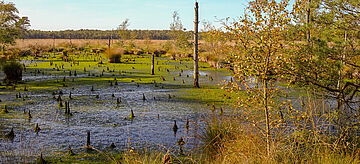
Peatlands store large amounts of carbon over long periods of time: the remains of dead plants do not immediately decompose – as in dry places – but slowly turn into peat under the surface of the water where the carbon remains stored. As ecosystems, peatlands provide habitats for unique animal and plant species, which depend on these special living conditions.
In Germany, however, 92 percent of peatlands have been drained. They are usually used as cropland or pasture land and for peat extraction. On contact with the air, the plant remains, which have accumulated over centuries and millennia, begin to decompose very quickly, releasing the trapped carbon as CO2 in the process. In 2020, these emissions amounted to around 53 million tonnes of CO2 equivalents, representing roughly 7.5 percent of total national greenhouse gas emissions.
In addition to the considerable emissions when peatlands are drained, native flora and fauna are lost along with the regulating effect on the water balance. Peatlands can store water in the landscape.
2. Near-natural water balance with vibrant rivers, lakes and floodplains
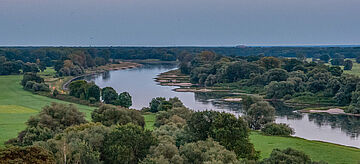
Floodplain of the Elbe near Roßlau
Intact water bodies – rivers and lakes – and their floodplains are hubs of biological diversity. Rivers and their floodplains can play a particularly important role in the biotope network. However, many rivers have been straightened and are practically cut off from their floodplains. Today, a good third of active floodplains are used for arable farming, settlements, transport infrastructure or commercial activities. Only nine percent of floodplains are ecologically intact.
In the protection of water bodies, particular advantage can be taken of the synergies of Nature-based Solutions (NbS): restoring water body systems and reconnecting floodplains secures refuges for a range of flora and fauna. At the same time, floodplains filter surface water and keep it in the landscape, preventing droughts in the process. They provide flood protection in the form of retention areas.
The aim is to keep more water in the landscape and scale back the rapid drainage of large areas. A larger and more evenly distributed supply of water also makes the existing ecosystems more resilient. It is often even the basic prerequisite for more extensive renaturation and restoration measures, e.g. rewetting peatlands.
3. Seas and coasts
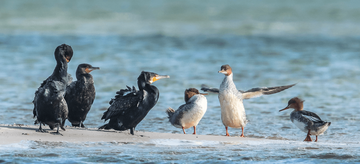
Marine and coastal ecosystems, including their habitats such as seagrass beds, salt marshes and kelp forests, as well as the sediments on the sea floor, naturally absorb carbon from the atmosphere. In the long term, they function as carbon sinks, and around the world fulfil this function to an even greater extent that terrestrial ecosystems. As habitats and nurseries for many marine species, intact marine ecosystems contribute to Nature-based Climate Action.
However, our seas have a poor conservation status. Besides suffering as a result of intensive use in some areas, pollution and accumulation of nutrients, the North and Baltic Seas are also affected by the climate crisis. Due to the climate crisis, they are becoming not only warmer and less well oxygenated, but also more acidic. That impacts the marine flora and fauna, and living conditions in the water, which in turn changes the functional capacity of the ecosystems and they become less resilient.
We need to understand seas and their coasts as a foundation of life and an essential component of the climate system. We can enhance their natural functions by protecting seas and coasts, ensuring they are used sustainably and increasing their resilience to climate-related changes. This is the focus of the German government’s marine protection initiative, and the marine and coastal measures of the Action Plan can make a key contribution.
4. Wilderness and protected areas
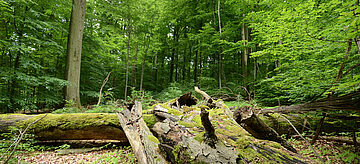
Areas where nature can evolve naturally over the long term are vital for biodiversity conservation and valuable for Nature-based Solutions. The aim is to preserve habitats through sufficiently large protected areas. In addition, strong connectivity between protected areas is important to ensure the resilience of the entire protected area network. Even smaller areas with natural dynamic development and small-scale protected areas can make an essential contribution here. One of the targets of the Global Biodiversity Framework is to conserve 30 percent of global terrestrial and marine areas by 2030. Nature-based Solutions will help improve the quality of existing protected areas and implement the global target at national level.
The EU Biodiversity Strategy calls for ten percent of European land and marine areas to be placed under strict protection by 2030. Wilderness areas and smaller sites that are left to develop completely naturally are of particular importance for achieving this target, but habitats that depend on use, such as extensively farmed, species-rich meadows or large pasture landscapes, can also play a role.
Protected habitats have particularly positive effects when they have a favourable conservation status. This is not fully the case for many German protected areas. To take more effective action in this area, we will improve the planning conditions and general bases for the management and maintenance of wilderness and protected areas.
5. Forest ecosystems
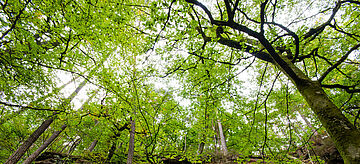
Forests can sequester large volumes of greenhouse gases. Trees, like all plants, remove CO2 from the atmosphere, convert it through photosynthesis and release oxygen. The resulting carbon compounds are stored, leading to the formation of wood – and the tree grows. That is the basis for the sequestration of large quantities of carbon in forests. At the same time, near-natural forest ecosystems are important habitats for many species of flora and fauna and also improve the local climate and landscape hydrology.
However, the last National Forest Inventory identifies only 36 percent of Germany’s forest as near-natural. In recent years, non-natural forests in particular have proven to be especially susceptible to drought damage and pest infestation. The systematic conversion of non-resilient forests and restoration of damaged forest areas aims to enable near-natural, climate-resilient forest ecosystems to evolve. The climate change adaptability and resilience of forests hinge on the biodiversity and structural richness of near-natural forest ecosystems.
In addition, we want to expand forest cover in Germany. This will allow us to increase the long-term capacity of forests to sequester carbon and create valuable habitats for the long term. This also contributes to the goal of planting three billion additional trees in Europe, as laid down in the EU Biodiversity Strategy for 2030 and the EU Forest Strategy. Furthermore, increasing forest cover enhances landscape diversity and the habitat quality for many species, in some cases also improving habitat connectivity.
6. Soils as carbon sinks
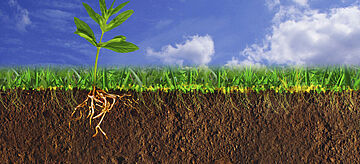
Soils are the main land-based carbon sinks. They play an important role in the release and sequestration of greenhouse gases, especially CO2. Healthy soils also strengthen the resilience of ecosystems to the climate crisis. Soil conservation and soil-friendly management that improves humus content prevent soil-derived greenhouse gas emissions and stabilise or increase the organic carbon content of soil.
Agriculture, which is the main land use in Germany, has a special role to play here. Impacts on soil vary greatly according to the type of farming being practised. Soil management must seek to enhance the capacity of soils for Nature-based Climate Action as carbon sinks, water reservoirs and filters, and to preserve and promote soil biodiversity. The same applies to forestry. Not least, more careful management of our soils is crucial for securing our basic food supply in the long term.
7. Nature-based Climate Action in settlement and transport areas
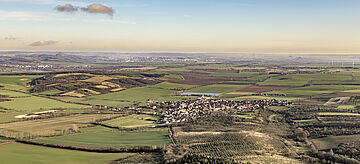
Green and open spaces in cities and towns are important recreational areas. The services plants provide for the urban environment can be felt in parks, urban forests, green belts and greened streets: they improve air quality by removing pollutants and CO2, give shade on hot summer days and provide additional cooling through transpiration. Interconnected green spaces act as cooling and fresh air channels. This urban nature offers habitat and refuge for many animal and plant species. It is crucial that we preserve and support this nature on our doorstep, and disseminate knowledge about it among experts and urban communities.
Beyond our settlements are far larger ecosystems. However, most of these are dissected by linear infrastructures like roads or railway lines, and the towns and villages on their margins encroach on them more and more. We want to counteract this increasing dissection and fragmentation of our landscape. We will reduce interventions in nature and landscape with a view to, for example, reducing land take for human settlements and transport to under 30 hectares per day by 2030. We want to improve connectivity of already fragmented habitats and restore ecological permeability. This strengthens ecosystem performance and supports Nature-based Climate Action.
8. Data collection, monitoring, modelling and reporting

To pursue Nature-based Climate Action effectively, we need to systematically record the status and development of our ecosystems. Only this will enable us to recognise trends quickly and counter them where necessary. Emissions reporting in the LULUCF sector is only as accurate as the available data for ecosystems in this sector.
We will improve networking among the many institutions already gathering a range of data on ecosystems in Germany. This is important as often correlations only become apparent when observations from different fields are combined. We will also continue to harness data from new sources, for instance satellite remote sensing, and incorporate it into the existing structures.
The expanded data basis will be used to adapt and improve the tools for ecosystem modelling. A more robust characterisation of the current conditions will allow more reliable projections of future ecosystem developments, also with a view to the goals of the Climate Change Act (Klimaschutzgesetz).
9. Research and capacity building

Ecosystems are comprised of diverse interdependencies that can be very complex. Climatic conditions, landscape form, type and methods of human use, nutrient supply and many other factors influence the occurrence of animal and plant species and other (micro)organisms. In turn, these impact living conditions in and around the respective ecosystem. However, the accelerated climate crisis and unsustainable uses are affecting the balance of our ecosystems, forcing them to adapt quickly to new conditions. We need in-depth research on these interactions in our changing ecosystems. The better we understand the interdependencies, the more precisely we can tailor the options for Nature-based Climate Action.
We are already familiar with many measures which can effectively advance climate action and biodiversity conservation – this Action Plan on Nature-based Solutions for Climate and Biodiversity is a testament to that. What is vital, however, is that this knowledge is available in the places where measures can be implemented. Stakeholders who own or manage suitable sites need support in planning and implementing NbS, and contact points which cover a broad spectrum of knowledge.
10. Cooperation in the EU and the international community

Nature-based Solutions can only succeed in close cooperation at international and EU level. The German government will continue to promote Nature-based Climate Action and advocate an ambitious approach in international cooperation at bilateral and multilateral level and in all relevant EU processes.
Germany made strengthening NbS and therefore Nature-based Climate Action a cross-cutting topic for the climate and environment track of the G7 negotiations. At European level, many of the European Commission’s legislative proposals and initiatives that are based on the Green Deal and especially the Fit for 55 package focus on Nature-based Climate Action or NbS.
We will support NbS at international level too, continuing to play our part in implementing the Convention on Biological Diversity, the Paris Climate Agreement, the Convention to Combat Desertification, the UN Decade of Ecosystem Restoration, the UN 2030 Agenda and many other important regulations and initiatives relevant for Nature-based Climate Action.
